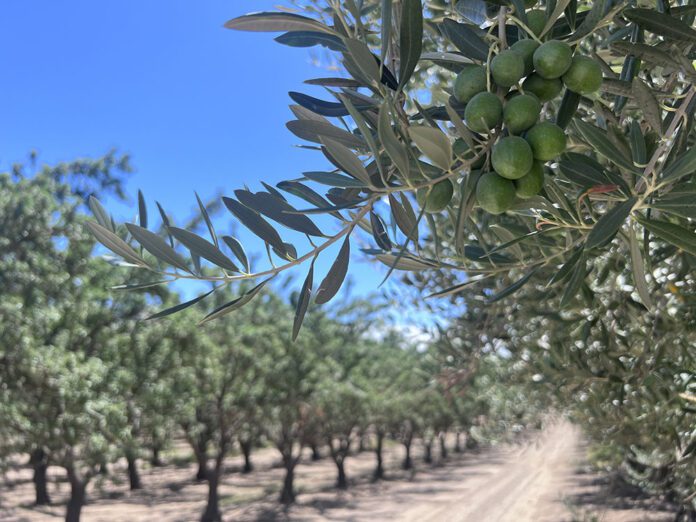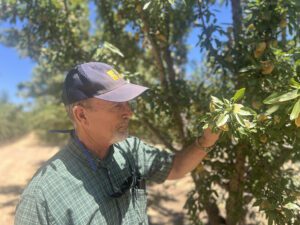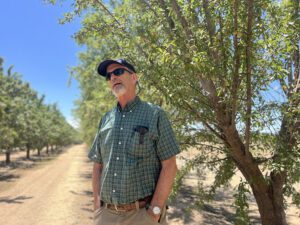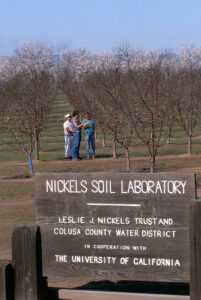
Listen to the audio version of this article. (Generated by A.I.)
In the heart of Arbuckle, Calif., Nickels Soil Lab has quietly shaped the way tree nut growers farm for more than six decades. From drip irrigation adoption in the 1980s to today’s rootstock, pruning and orchard recycling trials, the privately owned research site has served as a proving ground for practices many growers now take for granted.
What sets Nickels apart is its unique setup. It’s a working commercial farm left in trust by L.J. Nickels in 1959, managed in partnership with UC ANR, UCCE and the Colusa County Water District. Proceeds from almond, walnut and olive harvest sales help sustain operations, while UC researchers and farm advisors use the site to test ideas that are often too risky or long-term for commercial orchards.
“It’s a private farm, but it functions a lot like a UC field station,” said Franz Niederholzer, UCCE farm advisor and research coordinator at Nickels.
L.J. Nickels wanted it to be a place where you could try things most growers wouldn’t want to risk on their own ground.
“Supporting Nickels isn’t just about the projects happening now,” Niederholzer said, “it’s about making sure the industry has a place to test ideas, share results and prepare for whatever comes next.”

A Place to Test the Hard Ground
For Arbuckle grower Gerry Rominger, Nickels’ location is one of its biggest strengths. Just a few miles from his operation, the site represents the challenges many growers face across the Sacramento Valley.
“Most of what Nickels farms is on poorer soils, ridges, swales, lighter ground,” Rominger said. “That’s exactly where a lot of orchards have been planted in recent decades. The research done there is directly applicable to real-world conditions.”
Rominger said he has seen decades of discovery filter down from Nickels to everyday practice, from drip irrigation breakthroughs to leaf sampling standards.
“So many of the advancements growers rely on now were first tested at Nickels,” he added. “It’s a place where problems get identified and solutions get shared.”

Practical-Scale Research for Almonds
Mel Machado, vice president of member relations at Blue Diamond Growers, called Nickels a “solid asset” not only for local producers but for the wider industry.
“It’s a place where UC can try different things and show growers the results,” Machado said. “The value is in the scale. These are production orchards, not just a handful of replicated trees, so it’s practical and repeatable, and that resonates with growers.”
Machado compared the site’s role to other landmark research efforts in California, noting that while Nickels might not always deliver “earth-shattering” discoveries, its steady stream of credible, applied research has helped move the industry forward.
“Look at whole-orchard recycling,” Machado said. “At first, people rolled their eyes at those wood chip trials, but it turned out to be critical. Nickels gives us that kind of testing ground, sometimes for ideas that seem crazy until we realize we’re going to need them.”
“Nickels takes on trials that individual growers wouldn’t dare risk. They’ll push the envelope so the rest of us don’t have to gamble our orchards. If that goes away, we all lose a critical testing ground.”
– Hal Crain, walnut grower
Rootstocks, Pruning and Dormancy Research in Walnuts
For walnut growers, Nickels has been equally vital. Hal Crain, a grower and member of the California Walnut Board’s Production Research Advisory Council, pointed to several key projects.
“The rootstock trial for walnuts is probably the most important,” Crain said. “It’s hard to find growers willing to host that kind of work because of the complexity and the need for replicated harvests. Having it at Nickels is a big deal.”
Crain also highlighted pruning and hedging trials that began decades ago, which influenced modern high-density walnut systems. More recently, the site has hosted trials with Dormex, a dormancy-breaking aid being studied to address non-uniform bloom after winters with insufficient chill hours.
“With walnuts, uneven bloom can lead to poor nut set and uneven maturity at harvest,” Crain said. “Dormex has potential, and Nickels is the right place to vet it.”
He said having a site where multiple trials can run at once, under close observation, saves strain on both researchers and cooperating growers.
Nickels’ ability to host concurrent, long-term projects is what makes it invaluable, Crain added.
“If Nickels disappeared, you’d lose that concentrated research hub,” he said. “You’d need dozens more grower cooperators around the state to replicate the same volume of work, and that’s just not realistic.”

A Shared Resource for the Industry
While the lab is in the northern part of the state, its influence extends well beyond the Sacramento Valley. Machado noted that growers from the San Joaquin Valley frequently attend the annual Nickels field day, underscoring the site’s statewide relevance.
“There are people who drive up just to see what’s happening there,” Machado said. “It’s not about geography, it’s about good, solid work that benefits growers everywhere.”
Rominger echoed the point, noting that Nickels also serves as an educational hub.
“At a field day, you can see six or eight projects in one place, side by side,” he said. “That’s powerful. You walk away with information you can use right away.”
Sustaining the Legacy
But sustaining that resource is no small feat. Walnut and almond market downturns have strained the trust’s ability to support operations purely on crop income. That reality has made outside support, from commodity boards, grants and growers themselves, more critical than ever.
“This is not an easy time for farming,” Niederholzer said. “Costs are up, returns are down, and Nickels feels that like everyone else. But the difference is, if we can’t fund the work here, it’s not just one farm that loses out, it’s the entire industry.”
Crain said that’s why grower buy-in matters.
“Nickels takes on trials that individual growers wouldn’t dare risk,” he said. “They’ll push the envelope so the rest of us don’t have to gamble our orchards. If that goes away, we all lose a critical testing ground.”
Looking Forward
Whether from researchers, growers or representatives of the almond and walnut sectors, the message is clear: Nickels Soil Lab is a cornerstone of California’s tree nut industry.
“Had it not been done at Nickels, where would we be?” Machado said. “Sometimes you don’t realize how valuable steady, consistent research is until you imagine farming without it.”
Niederholzer put it more bluntly.
“Supporting Nickels is about supporting the future,” he said. “It’s making sure we have a place to ask the hard questions, test the new ideas and prepare the next generation of growers.”
To help sustain this one-of-a-kind research site, a fundraiser dinner is set for Dec. 4, 2025 at the Arbuckle Golf Club. Hosted by JCS Marketing, Inc. and West Coast Nut, the event will feature an auction and dinner, aimed at raising funds to ensure Nickels can continue serving as a vital testing ground for California agriculture. More details and ticket information are available at myaglife.com/fundraiser.

Kristin Platts | Digital Content Editor and Social Correspondence
Kristin Platts is a multimedia journalist and digital content writer with a B.A. in Creative Media from California State University, Stanislaus. She produces stories on California agriculture through video, podcasts, and digital articles, and provides in-depth reporting on tree nuts, pest management, and crop production for West Coast Nut magazine. Based in Modesto, California, Kristin is passionate about sharing field-driven insights and connecting growers with trusted information.















